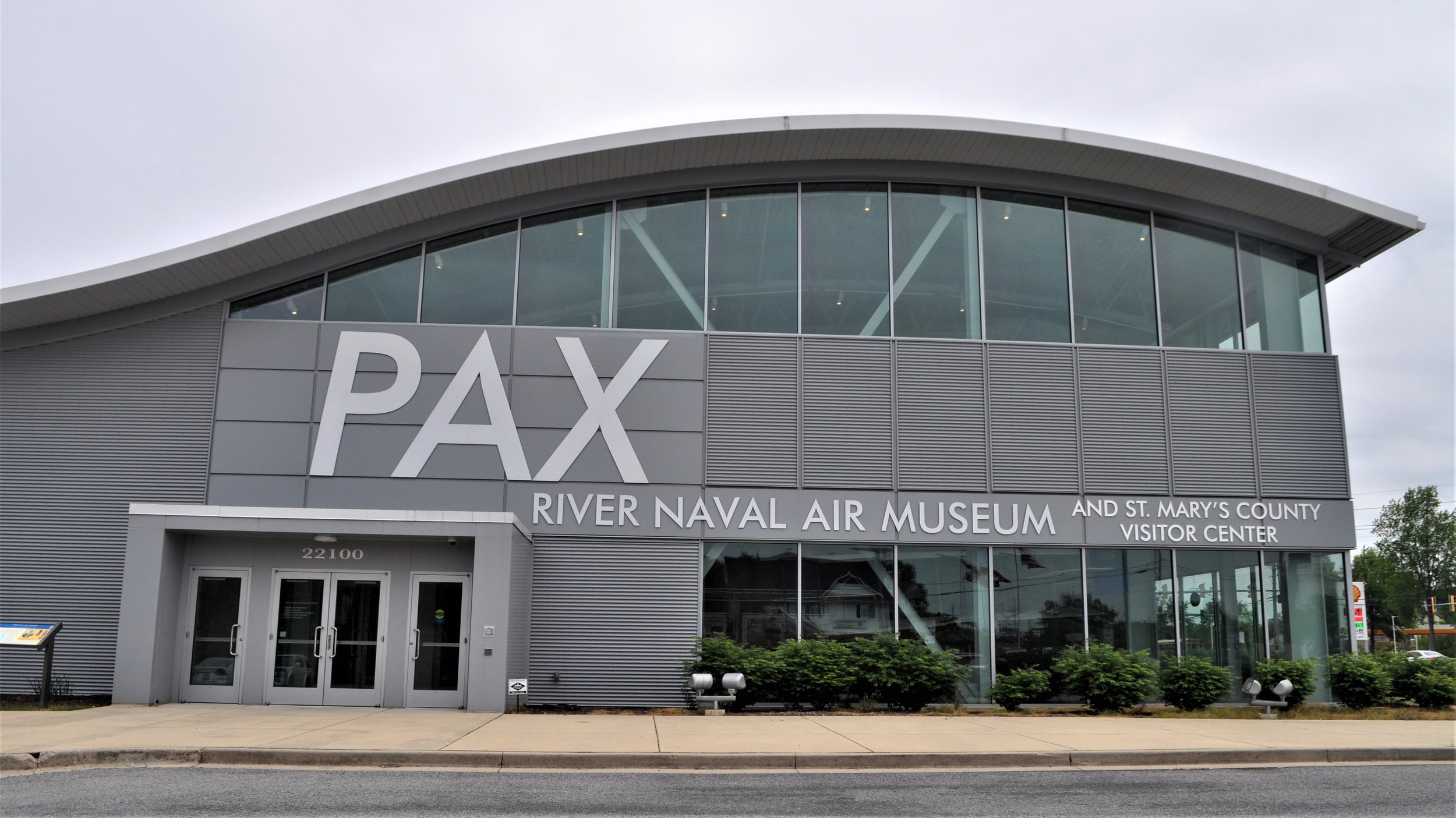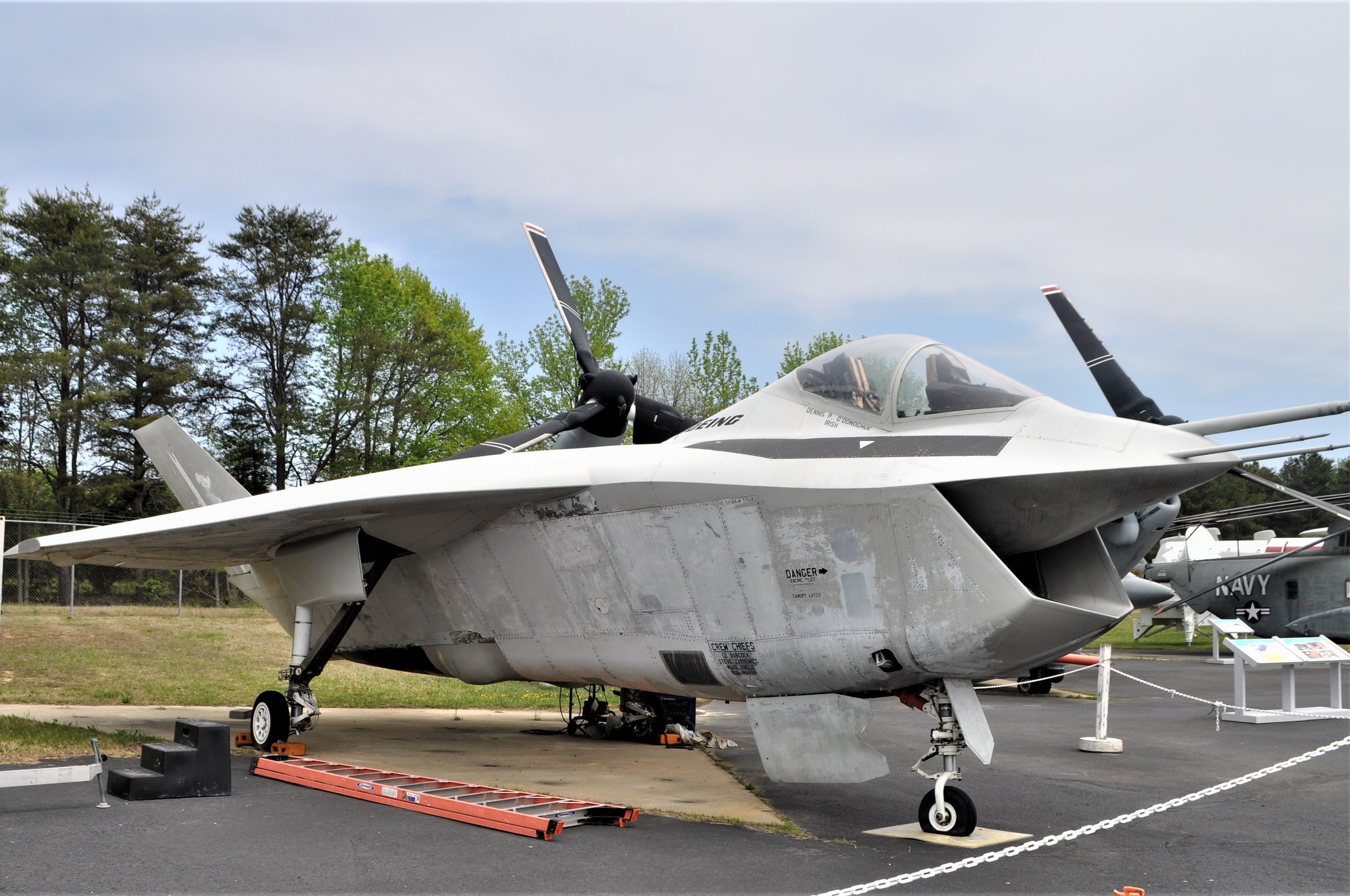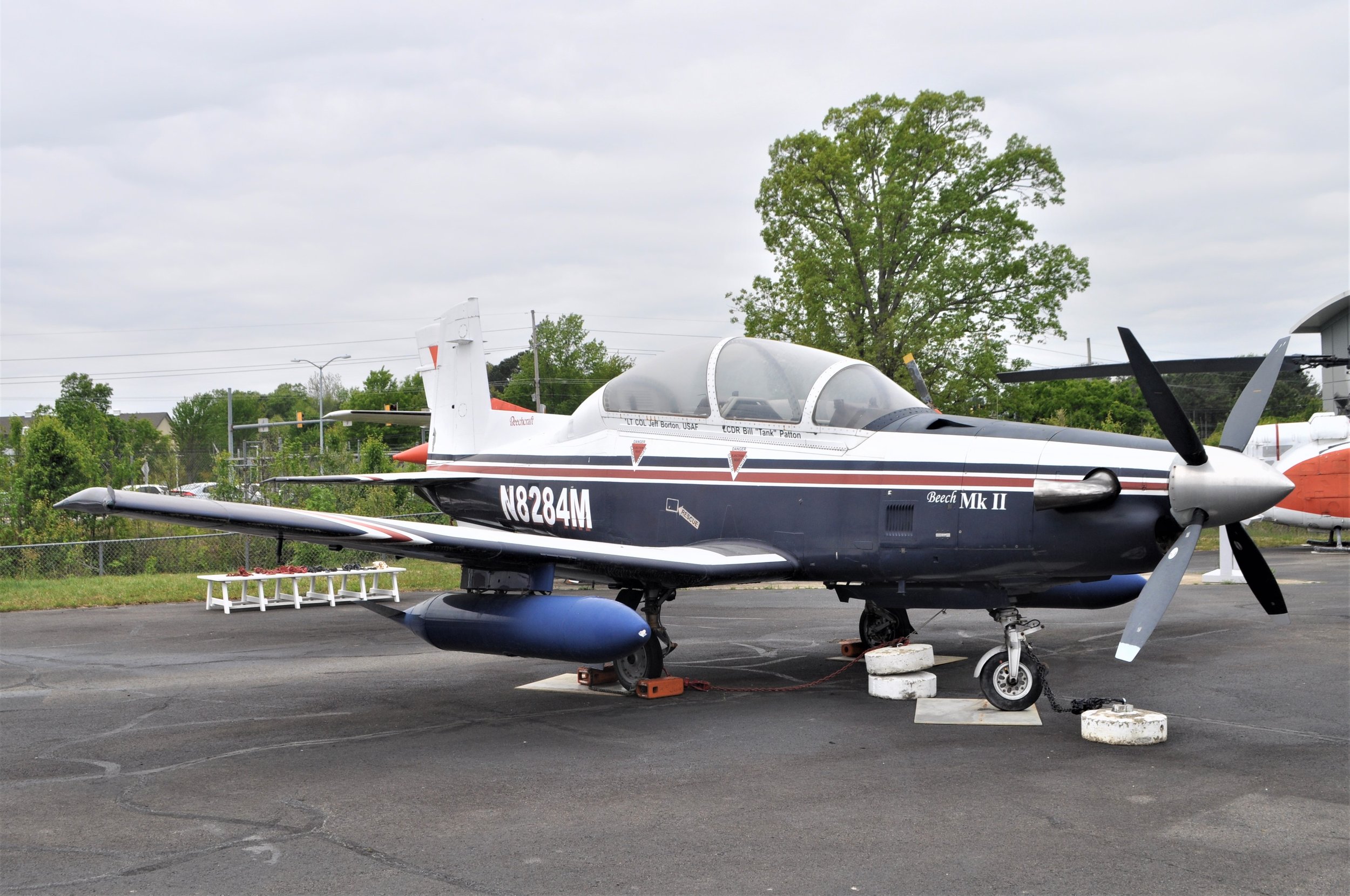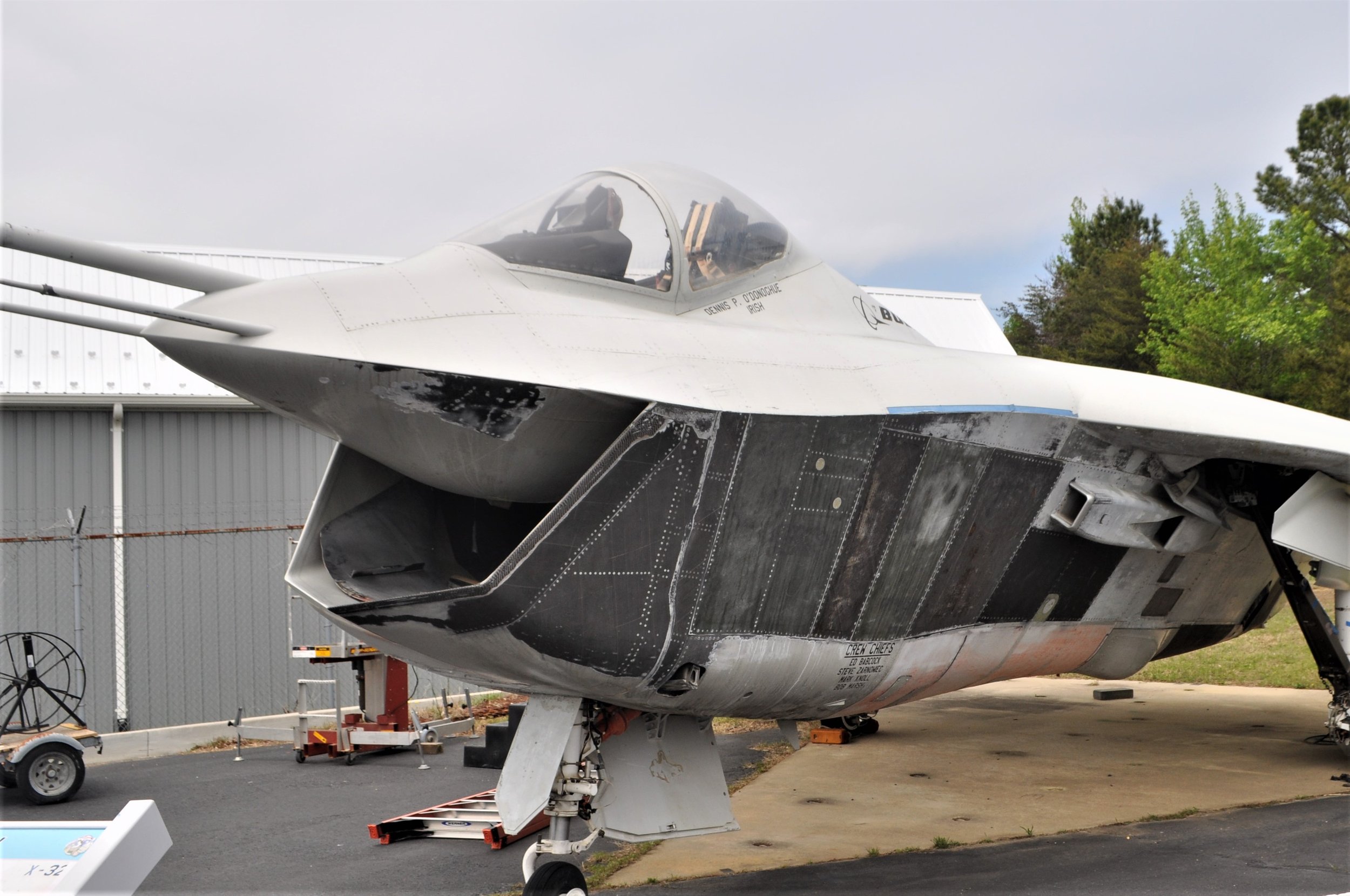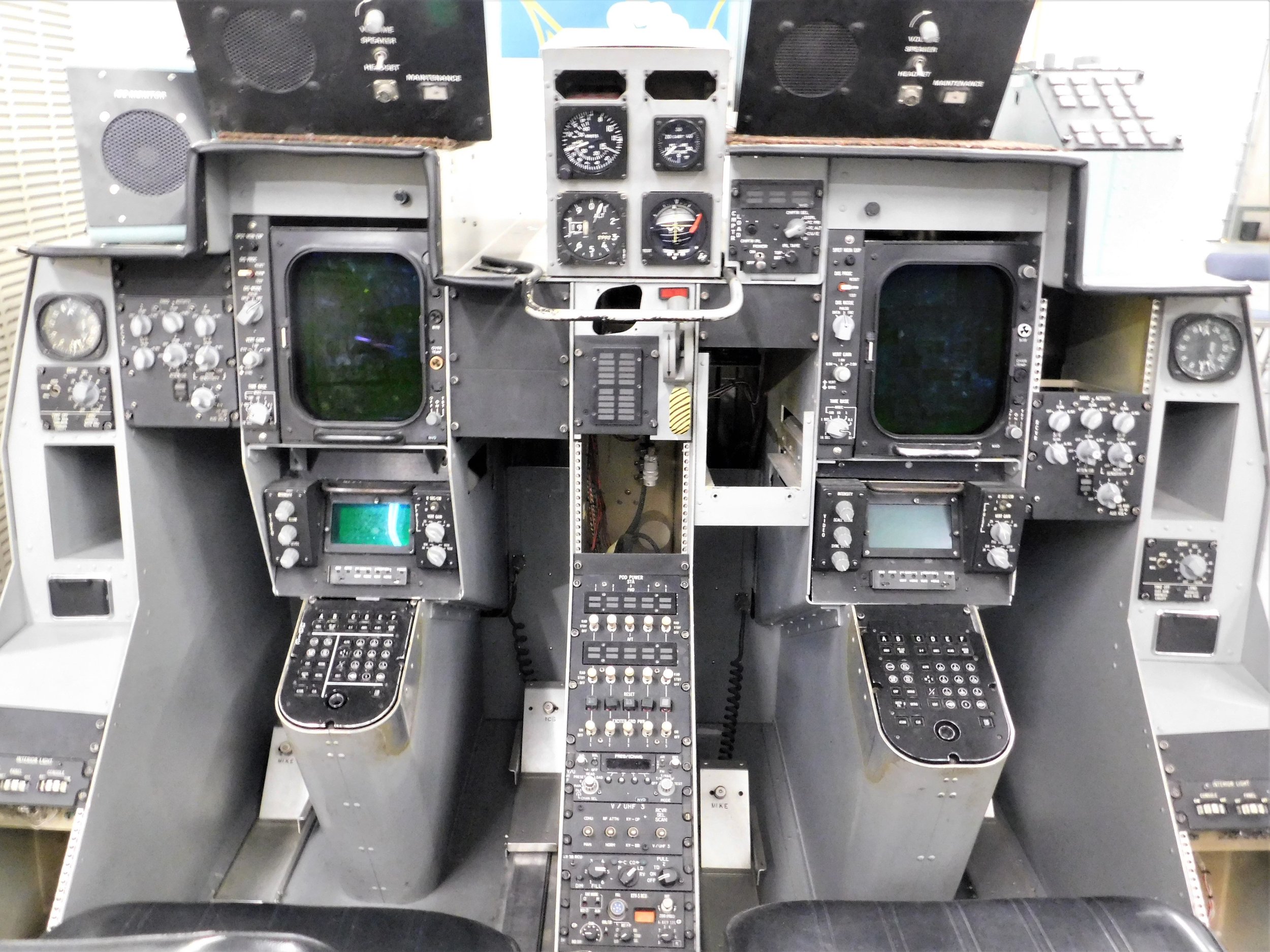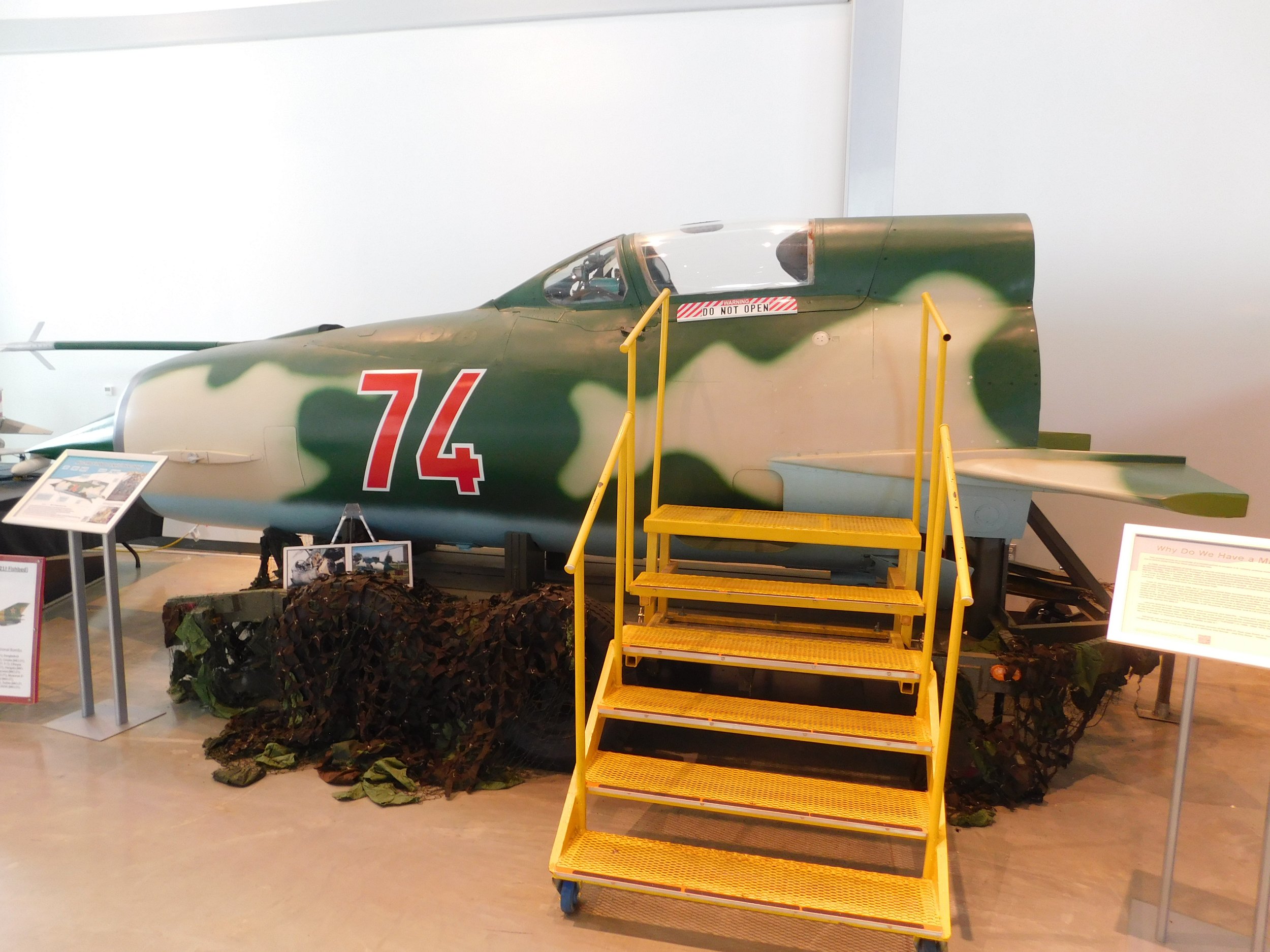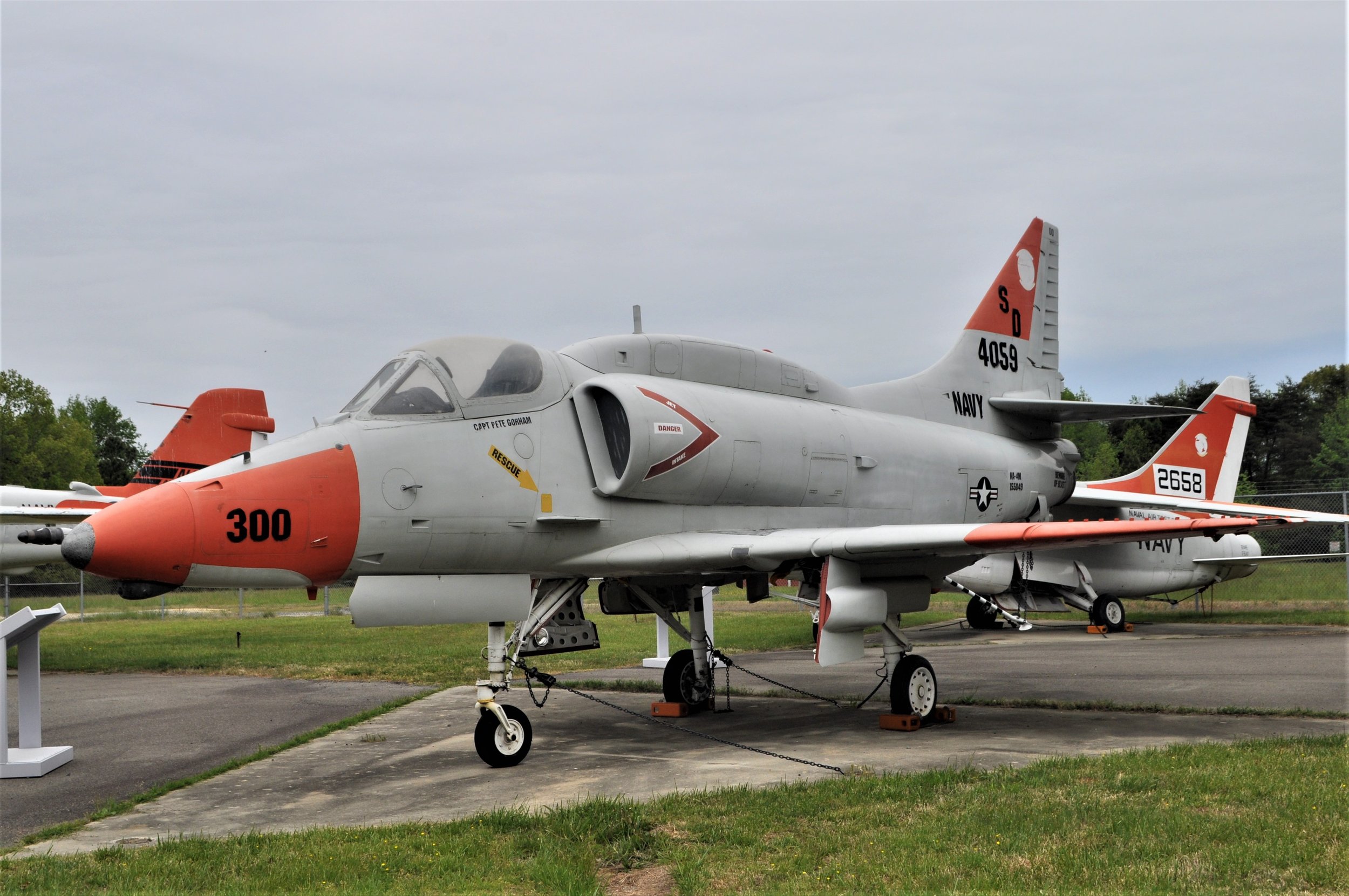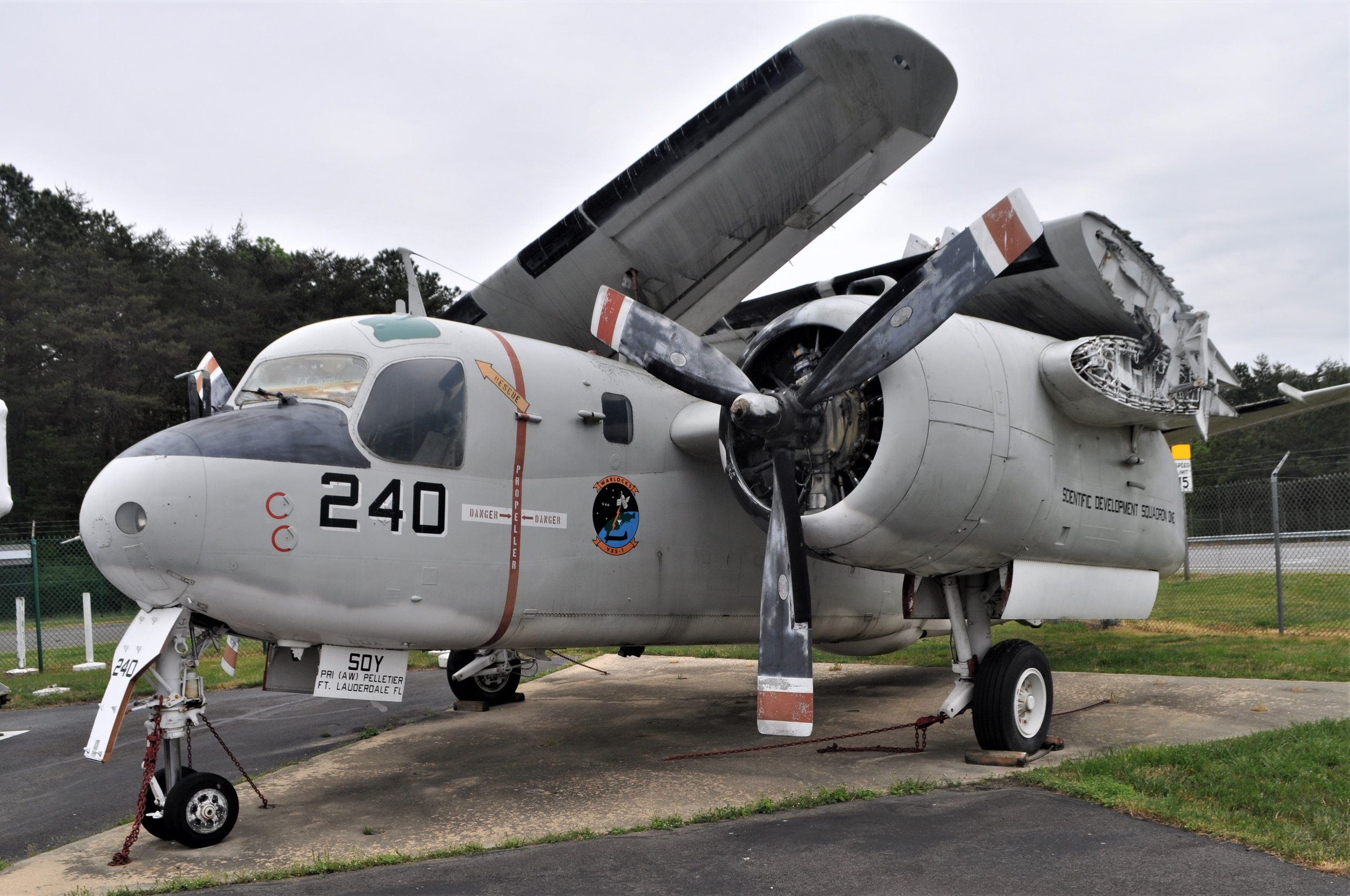Patuxent River Naval Air Museum
Issue 34 A visit to the PAX River Naval Air Museum, Lexington Park MD May 2022
———————————————————————
In the 1990s, a contest was announced to produce a Joint Strike Fighter (JSF) that would replace various aircraft types for the Air Force, Navy, and Marines, as well as for the services of a number of other countries. In 1996, Boeing and Lockheed Martin were chosen to compete for the contract and each company was given $750 million to produce two prototypes. Boeing produced the X-32 and Lockheed Martin produced the X-35.
The concept would require three versions of the selected fighter- a conventional takeoff and landing version (CTOL-A model), a short takeoff and landing version (STOLV- B model), and a carrier version (CV- C model). In 2000 and 2001, the four prototypes were tested and, in October 2001, the Lockheed Martin X-35 was announced as the winner. The design was developed into the F-35 Lightning II which first flew in 2006 and is still being produced today.
The four prototype aircraft were retired as soon as the competition was complete and two of them, the Boeing X-32B and the Lockheed Martin X-35C, are on display at the Patuxent River Naval Air Museum.
Boeing X-32B
Lockheed Martin X-35C
—————————————————————————-
In 1937 the Navy's Bureau of Aeronautics decided to build a base to consolidate its flight testing programs that were scattered around the country. Cedar Point in Maryland was chosen due to its isolated location, sitting on a peninsula between the Chesapeake Bay and the Potomac River. Naval Air Station Patuxent River officially opened in April 1943. The name Patuxent River was chosen, rather than Cedar Point, to avoid confusion with the Marine Base at Cherry Point NC. The Navy Test Pilot school was transferred to Pax River from NAS Anacostia in 1945 and it remains the home of the Test Pilot School today.
With the obvious historical significance of all the research that had gone on at Pax River, a committee was established in 1974 to plan for the establishment of a museum. The Naval Air Test and Evaluation Museum (NATEM) Association was approved and the Navy provided a building in 1976. The Patuxent River Naval Air Museum (PRNAM) opened in 1978 and it was recognized by the Secretary of the Navy as one of the 10 official Navy museums.
In 2016 a new building, the Test and Evaluation Hall, was opened. By this time, due to a reduction in Navy funding, the Museum had become a private, non-profit organization.
The museum has three main sections with the bulk of the aircraft on display on the flight line behind the buildings. There are around 25 planes as well as several ground equipment items to see. At first glance, the majority of the planes look like the planes I would have seen while on active duty in the first half of the 1970s. When you start to read the display placards, however, you learn that these are mostly one of a kind test aircraft.
This LTV NA-7A Corsair II, BuNo 152658, is a good example. Outwardly indistinguishable from a Navy fleet aircraft, this A-7 spent its entire life as a test aircraft. Delivered in 1966, it was used for Board of Inspection and Survey trials, basically the Navy acceptance trials. It was also used in carrier suitability trials on the USS America. In 1969 it was reengined with the Allison TF-41 engine (a licensed built version of the Rolls Royce Spey) replacing the original Pratt & Whitney TF30-P-6. After testing in this aircraft, the TF-41 engine was used in all future A-7s. This A-7 served in its testing role until 1978 and joined PRNAM in 1979. It was uniquely designated as an NA-7A, due to its permanent testing status.
The Douglas F-6A Skyray first flew in 1948 (it was called the F-4D prior to the 1962 military redesignation). It was developed after WW-II from German experiments with delta wing design, which proved ideal for interceptor aircraft- providing an excellent rate of climb. The Skyray set five time-to-height records and was the first Naval aircraft to exceed the speed of sound in level flight. In 1953, the F4D was the first carrier aircraft to set a world speed record.
Photo courtesy of Robert Sullivan
The wing of the Skyray is not a full delta and it was developed from the design of the German Me-163.
The aircraft in the museum, BuNo 134764, flew at Pax River for testing in 1957 and 1958 and was then assigned to several Navy and Marine squadrons. It returned to Pax River in 1961 to serve at the Navy Test Pilot School to demonstrate flight characteristics of the delta wing. It was retired from the Navy in 1966.
The Raytheon T-6A Texan II was developed from the Swiss Pilatus PC-9. It is the primary trainer for the U.S. Air Force and the U.S. Navy, replacing the T-37 for the Air Force and the T-34C for the Navy. The Navy is in the process of replacing the T-6A with the T-6B, which has upgraded avionics and a glass cockpit. Raytheon changed their name to Textron in 2014, when they acquired Beechcraft, hence the various designations of the Texan II as Raytheon, Textron, or Beech.
The Texan in the museum was never assigned a Navy bureau number as it is essentially a hand-built prototype, built from a Pilatus PC-9. It was used by Raytheon and the FAA for testing as well as by the Navy at PAX River. Production T-6 IIs became available in 2000 and this prototype Texan, N8284M, was retired and transferred to the museum.
Returning to the opening story about the JSF competition, this Boeing X-32 is a B model, the STOLV version. The intent, of course, in building a Joint Strike Fighter is to reduce costs (we won’t get into how well that always works out!). Lockheed Martin and Boeing were limited to the $750 million government award, with no additional company funds to be used. This required the two companies to develop cost-saving materials and techniques. One way Boeing did this was to use thrust vectoring (much like the Harrier) to achieve vertical takeoff and landing. Lockheed Martin chose a somewhat more difficult route by adding a lift fan arrangement. Although both the X-32 and the X-35 met all the testing requirements, the X-35 was able to do a vertical takeoff, transition to level, go supersonic, and then land vertically. The X-32 did not accomplish this all in one flight. This is probably one of the main reasons that the X-35 was named the winner.
This X-32 first flew in March of 2001 and was tested both at Edwards Air Force Base and at Pax River. It flew 78 flights and 43 hours and was transferred to PRNAM in 2005. It was restored in 2009 and is currently undergoing a fresh restoration. The other X-32 prototype, an A model, is on display at the Air Force Museum in Dayton.
This Lockheed X-35C was the prototype for the Navy F-35C, the carrier version of the Lightning II. It is bigger than the A and B models, with larger wings (that fold at the tips) to allow for slower carrier approach speeds. This X-35 differs from the production F-35 in a variety of ways and the museum does a great job with a number of placards explaining various aspects of the X-35 and its testing. Some of the differences on the prototype are cost saving measures. The landing gear, for instance, are from other aircraft. The nose gear is from an F-15 and the main gear is from an A-6. There are doors on top of the fuselage that are lift fan doors, although the C model does not have a lift fan. The prototype has a two-piece canopy while production aircraft have a single piece canopy. Production models are somewhat stealthy, while the prototypes were not- mainly due to the treatment of the engine intakes and exhausts (which adds to the cost). All of these differences are interestingly described around the aircraft.
The other X-35 prototype was originally built as an A model and then converted to a B model. We saw that plane at the Smithsonian’s Udvar-Hazy Center in Issue 28.
The X-35 is displayed inside the new Test and Evaluation Hall. The T&E Hall features several aircraft, from a replica Curtiss A-1 Triad to the Lockheed Martin X-35C, along with galleries such as the History of Naval Air Station Patuxent River and Naval Aviation in Space. This building continues to develop and a Women in Aviation exhibit will open soon.
The Northrop T-38 Talon is probably best known as the Air Force advance trainer, a role which it has served in since 1961. It is estimated that over 50,000 pilots have trained in the T-38. It will eventually be replaced by the Boeing–Saab T-7 Red Hawk.
The Navy has only used the T-38 as aggressor aircraft at the Top Gun School and, as this aircraft, at the Test Pilot School in Patuxent River. It is the main aircraft used for training during the 11-month long school. Many astronauts have gone through Navy Test Pilot School, including: John Glenn, Wally Schirra, and Scott Carpenter.
In November of 1910, Curtiss Aircraft demonstrator pilot Eugene Ely took off from the deck of the cruiser USS Birmingham, the first time a plane took off from a ship. In January 1911, Ely made the first ship board landing on a platform erected on the USS Pennsylvania. These events were the beginnings of a long relationship between Curtiss and the Navy. The Navy’s first aircraft was a Curtiss A-1 Triad. Purchased in July 1911, the Curtiss pusher was called the Triad due to its ability to operate on land, sea, and in the air.
Before selling the Triad to the Navy, Glenn Curtiss had established a flying school in San Diego. There, Ely had taught Lt. Theodore Ellyson to fly, making him Naval Aviator #1. Many of the Navy’s original aviators learned to fly on the Triad and the first Naval flight experiments were carried out with the A-1. The world’s first night water landing as well as the first catapult shot off a ship were made with the Triad (although the cat shot was not successful, with Ellyson and the plane ending up in the Severn River). The A-1 flew 285 test flights before it was damaged beyond repair in an accident in 1912.
In 2011, on the 100th anniversary of the purchase of the Navy’s first aircraft, this A-1 replica was donated to the museum by Chapter 478 of the Experimental Aircraft Association (EAA) from St. Mary’s County. Although not a flying replica, this may be the most thoroughly researched and accurate replica of the A-1. A number of photographs accompany the display, describing and honoring the Triad which was certainly the very beginning of aircraft test and evaluation by the U.S. Navy.
The building next door to the Technology and Engineering Hall is the Flight Technology Hall and, like the T & E Hall, it is still evolving into its final configuration. Located on the site of the original museum building, it contains a wide variety of exhibits including: unmanned aerial vehicles, aircraft engines, ejection seats, and an array of models of aircraft and aircraft carriers. The building also houses the museum’s art room, a STEAM classroom, and a 120-seat event area used for military ceremonies and lectures.
Northrop Grumman X-47A Pegasus
Several drones are on display and, like other areas of the museum, there are placards giving excellent information about testing, development, and other interesting facts.
There are lots of acronyms associated with drones, such as UAV (unmanned aerial vehicle) and UAS (unmanned aircraft system). The X-47A is part of the United States Navy's UCAS-D (Unmanned Combat Air System Demonstrator) program, also named UCAV (Unmanned Combat Aerial Vehicle).
The Northrop Grumman X-47A Pegasus in the museum is a full-scale constructor’s model of a demonstration drone that first flew in 2003. Built mostly of composite materials, the X-47A was constructed by Burt Rutan’s Scaled Composites in Mojave California.
Public domain photograph from defenseimagery.mil by MC2 Timothy Walter
The Pegasus program led to the X-47B, which the Navy tested at Pax River to evaluate carrier suitability of UAVs. Two X-47Bs were built, with the first flying in 2011. Earlier drone tests on carriers had shown that they would need to operate just like manned aircraft because independent launching, such as with rocket assist, was too disruptive to carrier operations. To that end, the two Pegasus aircraft were tested on several carriers including the USS George H.W. Bush (CVN-77). The UAVs made arrested landings and catapult shots during normal carrier operations. They were also evaluated for night flying and modified for air refueling.
X-47B making a successful arrested carrier landing. Public domain Photograph from Defense.gov News Photos archive by Capt. Jane E. Campbell.
Although the X-47B tests were quite successful, the Navy abandoned the testing around 2015 and has now moved on to developing the Boeing MQ-25.
The Flight Technology Hall has two very detailed and interesting aircraft carrier models on display.
In 1893, the Navy began constructing large-scale models of ships. These builder’s models were usually made while the ship was under construction and were used to help visualize how the ship would look and operate. Typically, only the first ship of a specific type is modelled and currently there are over 1900 models in the Department of the Navy collection. Many of them are on loan to museums such as these two in the Pax River Naval Air Museum.
Above is the builder’s model of the USS Commencement Bay (CVE-105), a WW-II era escort carrier. Escort carriers (often called jeep carriers) were smaller than full sized carriers and cheaper and quicker to build. They were relatively slow, but they were quite effective in their main role of protecting convoys on the North Atlantic. Of the approximately 150 carriers built during WW-II, 122 were escort carriers. The Commencement Bay was launched in 1944 and first served as a training carrier. In 1955 it was re-designated as a helicopter carrier and then as a cargo/transport ship in 1959.
The Commencement Bay was the first of 19 carriers in its class and this 1/48 scale builder’s model was constructed by Gibbs and Cox Inc, a ship building company that constructed a number of these models from 1939 to 1962.
The second builder’s model on display is of the USS Hancock (CV/CVA 19). The Hancock was an Essex class carrier commissioned in 1944. She served in the Pacific during WW-II and was decommissioned at the end of the war. The Hancock was re-commissioned twice, converted to an angle deck, and finally retired in 1976.
Let’s return to the Flight line to see a few more of the planes on display.
The North American T-2 Buckeye was a long serving basic jet trainer for the Navy. Introduced in 1959, the T-2A had a single Westinghouse J34 engine. The first T-2s were assigned to VT-7, and then VT-9, in Meridian Mississippi, the home to basic jet training for many years. Later the T-2B was introduced with two Pratt & Whitney J60 engines. From the late 1950s until 2004, virtually every jet qualified Navy pilot and Naval Flight Officer (NFO) trained in the T-2.
The T-2 in the museum, BuNo 158320, is a C model which was the final production version, with two General Electric J85 engines. It served in the training command from 1971 until 2008, when it was transferred to VX-20 at Pax River. At Pax River it served as a chase aircraft for high-risk test flights and also in the Test Pilot School. When this T-2 was retired, in 2015, it made the final Navy-operated T-2 flight.
I flew the T-39D for NAS Pensacola flight support and one of our planes was BuNo 150985. This one is 150987 and, in 1975, it was based just down the hangar line from us in VT-10. The T-39s (and T-2s) served as navigator (NFO) trainers for many years in VT-10. Our three T-39s were originally NFO trainers but had been converted for use as VIP transports. Externally they looked the same but, on the inside, the radar and navigation equipment had been removed and six passenger seats had been added.
In 1977, 150987 was transferred from VT-10 to Pax River and the Sabreliner’s nose was replaced with an F/A-18 nose to test the radar installation. Later, the T-39 was returned to its roots and it was used at Pax River to train students in radar analysis.
Our “VIP” T-39s were interesting. As a navigator trainer, the T-39s needed a lot more electrical power than a standard Sabreliner. To supply the needed power, they were equipped with an hydraulic AC generator. It produced plenty of electrical power, but made more noise than both engines combined! As a trainer, the T-39 didn’t need an autopilot; ours didn’t have one. We didn’t have a yaw damper either. It wasn’t exactly a VIP ride for the admirals we carried around! There was a lot of dutch roll at altitude and you had to really concentrate on hand flying to give any semblance of a good ride. There was nothing we could do about the noise!
This McDonnell Douglas F-4J Phantom II, BuNo 153071, is another aircraft in the collection that spent all of its career at Pax River. First flown in 1966, this F-4 was mainly used in carrier suitability test and evaluation. It was also used in the development of the Aircraft Carrier Landing System (ACLS). The ACLS provides a coupled approach to a carrier landing. Today, the system is well developed but in the 1960s, this F-4 was used in the testing of the early generations that were less than sophisticated.
Another McDonnell Douglas product in the collection is this AV-8B Harrier II. Designed in England by Hawker Siddeley in the 1950s, the first six prototypes (named the Kestral) flew in the early 1960s. The first production model of the Harrier arrived in 1967 and. by 1971, the AV-8A was being flown by the U.S. Marines. The heavily modified AV-8B Harrier II, built under license by McDonnell Douglas, entered service in 1985.
This aircraft, BuNo 161576, was the fourth production AV-8B. It served with various departments at Pax River, including Air Test and Evaluation Squadron Five (VX-5). It was retired in 1999.
Let’s finish our visit to the Patuxent River Naval Air Museum with a look at this former Blue Angles F/A-18.
In previous issues we have talked about how the F/A-18s that the Blue Angels fly are just normal Navy aircraft that come from (and return to) the fleet. This Hornet, BuNo 162885, is no exception. Originally delivered in 1986, it joined Marine squadron VMFAT-10, a Hornet training squadron in Miramar California. It was later assigned to Pax River and the Navy Test Pilot School. After 16 years in that role, this F/A-18 was assigned to the Blue Angels. In 2020, the Blues transitioned to the F/A-18G, the Super Hornet, and this Blue Angel was transferred to the museum.
As with the rest of the museum, the placards around the Hornet add a lot of interesting information. Although this is a standard fleet F/A-18, there are a number of modifications required to make it into an airshow aircraft and one of the placards discusses those changes. Although an F-18 can fly inverted and pull negative Gs, the fuel system has an added pump to allow a longer time in a negative G condition. A standard F-18 has various low level warning systems and these have been modified to prevent unnecessary warnings during an air show. To assist in the low-level flying, however, there are additional terrain sensors on the wings. In the cockpit there is a stop watch for maneuver timing and the stick has an addition 40-pound tensor spring for more accurate inputs. The two other obvious changes are the addition of a smoke system and, of course, many gallons of paint and clear coat that take over 1200 man-hours to apply, resulting in the distinctive and attractive Blue Angels paint job. All of the changes to the Blue Angels aircraft and the maneuvers that will be performed are thoroughly tested here at NAS Patuxent River.
This unique museum is very well laid out and a great place to visit. It is one of those museums where you should plan on spending plenty of time, there are a lot of excellent items on display here.
Many thanks to Scott Grey, Museum Executive Director, for his assistance in researching this blog.
————————————————————————
To learn about what to do in the local area, museum hours and costs, as well as books to read and other interesting odds and ends, keep reading! At the end you will find a photo gallery of the entire museum.
-------------------------------------------------------------------
PLANNING YOUR VISIT
The museum is open Tuesday through Saturday 10am – 5pm and Sunday noon-5pm. Admission is $9 for adults, $7 for active duty, $7 for seniors, $4 for children ages 5-12, and free for children 4 and under.
FLYING IN
St Mary's County Regional Airport (2W6) is a full-service general aviation airport about five miles away. It has a 4150’ runway (11/29) and an RNAV approach to each runway. AirTec is a full service FBO.
LOCAL ATTRACTIONS
St Mary’s County is a rural area with water all around and lots of outdoor activities. https://www.visitstmarysmd.com/
Historic St Mary’s City was the site of the first capital of Maryland and is one of the premier historic sites in America. https://www.hsmcdigshistory.org/
WHERE TO EAT
The Museum staff recommended the nearby Blue Wind Gourmet café.
SUGGESTED READING
I have previously recommended one of my favorite books about the Wright Brothers, The Bishop’s Boys, by Tom Crouch. Another book by Tom Crouch that is really worth a read is Wings: A History of Aviation From Kites to the Space Age. Although this is the size and scope of a reference book, it is very readable, with stories woven in to the historical facts. Tom Crouch is retired from the Smithsonian Institute and is curator emeritus.
MUSEUM WEBSITE
MUSEUMS ARE WHERE YOU FIND THEM
This segment is dedicated to finding interesting aviation artifacts that are in public view- but not in an aviation museum. If you see one send a photo!
My wife Sheri recently had an overnight in Athens and came across these planes when she was walking back to the hotel. Thanks Sheri!
Photo courtesy of Sheri Bruno
Photo courtesy of Sheri Bruno
Photo courtesy of Sheri Bruno
Photo courtesy of Sheri Bruno
PHOTO GALLERY
click any photo to enlarge
Issue 34, Copyright©2022, all rights reserved. Except where noted, all photos by the author
